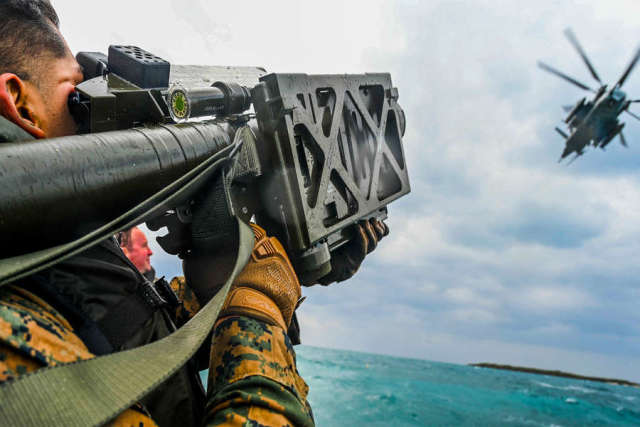Colonel of the General Staff Khodarenok called the minus of air defense means that the West handed over to the APU
Since the beginning of the special military operation, the Ukrainian leadership has repeatedly asked the United States and other NATO countries to "close the sky" over the country, but instead the collective West has limited itself to the supply of anti-aircraft missile technology. Military observer of the Newspaper.En" Mikhail Khodarenok figured out what kind of weapons Kiev received and whether it would help the APU.
At the beginning of the special military operation, the anti-aircraft missile forces of the Armed Forces of Ukraine, according to open sources, had the following weapons: 24-29 S-300P anti-aircraft missile divisions (11-13 S-300PT, 13-16 S-300PS), one or two S-300V divisions, 10 Buk-M1 divisions.
In the military air defense there were over 110 Osa-AKM air defense systems, up to 150 Strela-10, at least 600 Igla MANPADS, up to 90 Tunguska air defense systems, up to 30 ZSU-23-4 Shilka. At least 400 S-60 (57 mm) anti-aircraft guns and up to 300 ZU-23-2 (23 mm) were in storage.
There have been no new air defense equipment in the AFU since 1991. The existing fleet of weapons was modernized and maintained in working condition by its own forces.
The massive transfer of anti-aircraft equipment to Kiev from NATO began almost immediately after the start of a special military operation. At the same time, according to a number of Western media, some samples of equipment were provided to the Armed Forces of Ukraine shortly before the start of the conflict.
The United States mainly focused on the supply of the portable anti-aircraft missile system FIM-92 Stinger. This MANPADS is designed to defeat low-flying aerial targets (airplanes, helicopters, UAVs). In addition, the Stinger provides the ability to defeat unarmored ground or surface targets. The FIM-92 Stinger was developed by the American corporation General Dynamics Corporation and was adopted in 1981.
The UK, in turn, supplied Ukraine with several hundred Starstreak HVM short-range anti-aircraft missile systems. It was developed jointly by British companies BAe (now BAE Systems) and Short Brothers (now Thales Air Defense) and has been mass-produced by the latter at a Belfast facility for the British Army since 1997.
The Starstreak complex uses a high-speed two-stage solid-fuel rocket with a mass of 14 kg, a length of 1.4 m and a diameter of 130 mm placed in a transport and launch container. The maximum firing range is up to 7000-7500 m and the altitude reach is up to 4500-5000 m .
In addition, Ukraine received portable Martlet anti-aircraft missile systems from the UK. This MANPADS is a universal small-sized multi-purpose guided missile for surface-to-surface, surface-to-air and air-to-surface applications, developed under the code Lightweight Multirole Missile (LMM) by the British branch of the Thales Group (formerly Shorts Missile Systems) in the interests of the UK Ministry of Defense.
The two-stage solid-fuel engine provides the missile with a firing range of up to 8000 m, at an altitude of up to 5000-6000 m. A feature of the Martlet is the use of a two-channel guidance system - laser beam (as you can understand, completely borrowed from Starstreak, and apparently semi-automatic) and infrared at the final guidance site, which significantly increases noise immunity.
The intention to strengthen the air defense of Ukraine was announced in Berlin. Germany plans to supply Ukraine with 50 Gepard anti-aircraft self-propelled guns in the near future.
This ZSU is designed to cover ground forces and destroy air targets at a range of 100 to 4000 m and at an altitude of 3000-4000 m, flying at speeds up to 350-400 m / s, as well as ground targets.
An important point is that the development of the Gepard ZSU by the calculations of the air defense of Ukraine will take a relatively long time - up to two or three months. Shooting from Gepard using both optical sights and radar means is far from the easiest thing and requires highly qualified personnel.
Despite all the supplies of air defense equipment from NATO countries, the altitude range from 6 thousand meters is covered only by the Soviet complexes and systems of medium and long range available to the Ukrainian army at the beginning of the conflict.
The exception is the Soviet S-300PMU "Favorit" anti-aircraft missile division transferred by the Slovak authorities to Ukraine. At the same time, the complex supplied by Bratislava of Ukraine is far from the newest version of the anti-aircraft missile system, the regular functioning of which raises questions due to extreme wear and tear.
The opinion of the author may not coincide with the position of the editorial board.
Biography of the author:
Mikhail Mikhailovich Khodarenok is a military columnist for the newspaper.Ru", retired colonel.
He graduated from the Minsk Higher Engineering Anti-Aircraft Missile School (1976), the Military Air Defense Command Academy (1986).
Commander of the S-75 anti-aircraft missile division (1980-1983).
Deputy Commander of the anti-aircraft missile regiment (1986-1988).
Senior Officer of the General Staff of the Air Defense Forces (1988-1992).
Officer of the Main Operational Directorate of the General Staff (1992-2000).
Graduated from the Military Academy of the General Staff of the Armed Forces of Russia (1998).
Columnist of "Nezavisimaya Gazeta" (2000-2003), editor-in-chief of the newspaper "Military-Industrial Courier" (2010-2015).
Mikhail Khodarenok

